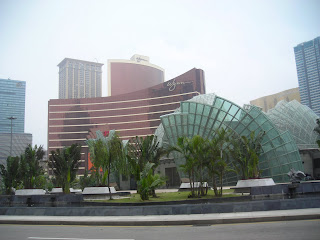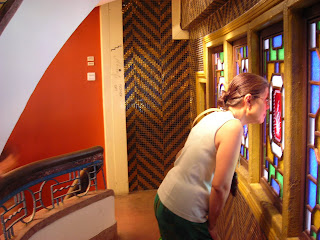I have been to Hong Kong many times before, but only this time did I really feel the city sink into me. This time I did not view the city through a haze of family members and schedules; nor as an overwhelmed teenager lost in the hypnotic shopping malls and daunted by the seemingly perfect Hong Kong women. This time returning to Hong Kong, I truly felt I saw the city for the good and the bad--Hong Kong women aren't perfect or all petite 00s. Also, despite the city's obsession with sanitation after SARS, Hong Kong cock roaches are huge and can fly! I would say that trumps any New York City pest I know. Additionally, what really helped shape my perspective of the city this time were just daily activities---getting my hair cut, taking the trolley, eating the spicy dark meat chicken sandwich at McDonald's, actually going out at night without chaperones, and of course seeing what Chinese art and expression is like in China.
Hong Kong consists of four main areas: Kowloon, Hong Kong Island, New Territories and the Outlying Islands. Kowloon is on the mainland and has most of the city's landmass. This is the area I am most familiar with but my friend Xiu Dan lives on Hong Kong Island, a section I would probably not have otherwise so thoroughly explored. Having recently relocated herself, we were prime matches to wander the city together in search of...well, simply the unseen and interesting.
Of course I took advantage of my amiable companion and swayed her in to visiting all the artsy, fartsy exhibitions I could find on the island. Below is a visit to the Hong Kong Arts Center in Wanchai which is a community gallery space and school.
These are a mixture of amateur and student works. My apologies, I forgot to jot the names of the artists with which to credit these works...perhaps you can see their signature scribbled faintly in the corner? In the first painting, I really appreciate the thin fluidity of his line. In the second, I like the color composition and energy. Pretty decent amateur work.
This painting below is inspired by Facebook and the virtual web of connections that has become our reality.
Next is The Cat Street Gallery in Sheung Wan which is on the eastern part of Hong Kong Island. Currently on exhibit where cheeky post-modern and expressionist works that were both sarcastically funny and visually inspiring.
Lotus Heartmantra Protection Suit, Hanna Hoyne, 2004, Korean and standard commercial papers, Chinese Joss paper, synthetic fabrics, glue, cane stitching
You Were A Great Time, Antoinette Wysocki, 2009, Acrylic and Mixed-Media on Archival Rag
Gossip Bone, Hanna Hoyne, (date?) Cardboard, masking tape, fiberglass, glue, plaster, kum-kum pigment, Joss paper
Invasion of the Tree Roots, Mother Nature, (date?), Tree roots, soil, stone wall
Hollywood Road links Sheung Wan to Soho (yes, like NYC Soho) and all along it there are contrasting contemporary art galleries and antique shops to duck in to. On the day we walked it was raining, so that proved to be most convenient. I really like contemporary Chinese Art maybe even more so compared to other countries. In the words of Joyce Gallery, "It is not just a new form of art expression, but it is also a true reflection of a dynamic China currently under a wave of dramatic social and ideological change". I don't have any corresponding pictures, but I encourage you to visit the gallery website here . They have a quirky collection of Chinese propaganda style paintings.
At the Contemporary by Angela Li gallery, there is no photography allowed...but of course I sneaked a few anyways. Feeling overwhelmed lately? Below is a life-size commentary on the onslaught modern people face with stimulus and distractions. The human model is made entirely of fiberglass and paper scraps from To-Do Lists.
Have you had a headache lately? In the background are negative and positive MRI images of the human brain stitched by hand from fabric. No matter how much we advance, sometimes we must rely on age-old traditional methods. Maybe it can also be viewed as traditional handicraft being superior to technology. To learn more about Contemporary by Angela Li and the represented artists, click here.
To round things up, of course there is the Hong Kong Museum of Art in Tsim Sha Tsui in Kowloon on the mainland. However, it is a daunting 6 floor megalopolis of both classical and contemporary art that I dared not attempt on my condensed visit. I will save it for another time as I hope there will be many.
Meanwhile, here are some shots from the outside where it is equally beautiful. Every night behind the museum there is a light show across the bay towards Hong Kong island. The light show is interesting, but also slightly tacky, ha! Anyways, stay tuned for more postings to come on Hong Kong food and commentary!



















































